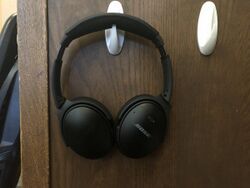Physics:Noise-cancelling headphones
Noise-cancelling headphones, or noise-canceling headphones, are headphones that reduce unwanted ambient sounds using active noise control. This is distinct from passive headphones which, if they reduce ambient sounds at all, use techniques such as soundproofing. Noise cancellation makes it possible to listen to audio content without raising the volume excessively. It can also help a passenger sleep in a noisy vehicle such as an airliner. In the aviation environment, noise-cancelling headphones increase the signal-to-noise ratio significantly more than passive noise attenuating headphones or no headphones, making hearing important information such as safety announcements easier.[1] Noise-cancelling headphones can improve listening enough to completely offset the effect of a distracting concurrent activity.[2]
Theory
To cancel the lower-frequency portions of the noise, noise-cancelling headphones use active noise control. They incorporate a microphone that measures ambient sound, generate a waveform that is the exact negative of the ambient sound, and mix it with any audio signal the listener desires.
Most noise-cancelling headsets in the consumer market generate the noise-cancelling waveform in real-time with analogue technology. In contrast, other active noise and vibration control products use soft real-time digital processing.
To prevent higher-frequency noise from reaching the ear, most noise-cancelling headphones depend on soundproofing. Higher-frequency sound has a shorter wavelength, and cancelling this sound would require locating devices to detect and counteract it closer to the listener's eardrum than is currently technically feasible or would require digital algorithms that would complicate the headphone's electronics.[3]
Noise-cancelling headphones specify the amount of noise they can cancel in terms of decibels. This number may be useful for comparing products but does not tell the whole story, as it does not specify noise reduction at various frequencies.
In aviation
By the 1950s, Dr. Lawrence Jerome Fogel created systems and submitted patents about active noise cancellation specifically in the field of aviation. This system was designed to reduce noise for the pilots in the cockpit area and help make their communication easier and protect hearing. Fogel was considered to be the inventor of active noise cancellation and he designed one of the first noise canceling headphones systems. Later on, Willard Meeker designed an active noise control model that was applied to circumaural earmuffs for advanced hearing protection. Noise-cancelling aviation headsets are now commonly available.[4] [5]
A number of airlines provide noise-cancelling headphones in their business and first class cabins. Noise cancelling is particularly effective against aircraft engine noise. In these cases, the headphones are about the same size as normal headphones. The electronics, located in the plane handrest, take the sound from the microphone behind the headphone, invert it, and add it back into the audio signal, which reduces background noise.
As a sleeping aid
Over the last few years, the use of noise-cancellation headphones as sleeping aids has increased.[6] Both active and passive noise-cancellation headphones and ear plugs help to achieve better noise isolation from ambient sounds, which is particularly helpful for people suffering from insomnia or other sleeping disorders, for whom sounds such as cars honking and snoring impact their ability to sleep. For that reason, noise-cancelling sleep headphones and ear plugs are designed to cater to this segment of patients.[7]
Drawbacks
Noise-cancelling headphones have the following drawbacks:
- They typically cost more than regular headphones.
- Active noise control requires power, usually supplied by a USB port or a battery that must occasionally be replaced or recharged. Without power, some models do not even function as regular headphones.
- Any battery and additional electronics may increase the size and weight of the headphones compared to regular headphones.
- The noise-cancelling circuitry may reduce audio quality and add high-frequency hiss, although reducing the noise may result in higher perceived audio quality.[8]
See also
- Active vibration control
- Noise-cancelling microphone
- Passive noise-cancelling headphones
- Throat microphone
References
- ↑ Molesworth, Brett; Burgess, Marion. (2013). "Improving intelligibility at a safety critical point". Safety Science (Elsevier) 51: 11–16. doi:10.1016/j.ssci.2012.06.006.
- ↑ Molesworth, Brett; Burgess, Marion; Kwon, Daniel (2013). "The use of noise-cancelling headphones to improve concurrent task performance in a noisy environment". Applied Acoustics (Elsevier) 74: 110–15. doi:10.1016/j.apacoust.2012.06.015.. Recognition and recall of audio information improved when 65 dB(A) background noise was blocked by noise-cancelling headphones, and performance was "no different" when listening with the headphones while at the same time working a mathematical puzzle, than while trying to listen to the same audio with neither puzzle nor headphones.
- ↑ Reinhard Lerch, Gerhard Sessler, Dietrich Wolf: Technische Akustik: Grundlagen und Anwendungen, Kapitel 14.7.3 Kopfhörer – Hörertypen, Verlag Springer (2008), ISBN:9783540234302, Seite 431
- ↑ US Grant, US2966549A. "Apparatus for improving intelligence under high ambient noise levels". https://patents.google.com/patent/US2966549.
- ↑ McKinley, L., Richard. "AUDITORY AND ACOUSTIC RESEARCH & DEVELOPMENT AT AIR FORCE RESEARCH LABORATORY (AFRL)". https://apps.dtic.mil/dtic/tr/fulltext/u2/a539451.pdf.
- ↑ Yu, Winnie & Smith, Michael W., MD (November 7, 2013). "Will a Gadget Help You Sleep?". http://www.webmd.com/women/features/sleep-gadgets-apps-tips#1.
- ↑ Jonaely, Rosarito (March 5, 2018). "How to get quality sleep at night?". Scalar (University of Southern California). http://scalar.usc.edu/works/how-to-get-quality-sleep-at-night/index.
- ↑ Beacham, Frank (August 17, 2016). "The Limits of Noise Cancelling Headphones for Professional Use". https://www.thebroadcastbridge.com/content/entry/6549/the-limits-of-noise-cancelling-headphones-for-professional-use.


